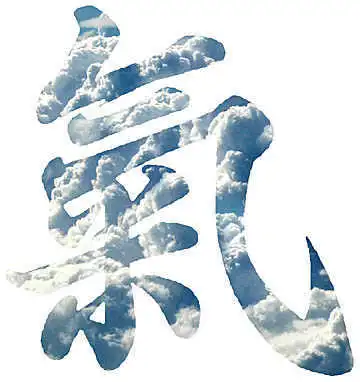FUNDAMENTALS |
BELIEFS A — Z |
|
INSPIRATION |
ENCYCLOPEDIA |
|
Air Qi, the Chinese life energy concept. Life Energy FundamentalsThe element most frequently connected to ideas of a life force in ancient traditions is air. This is the case with the Chinese qi (see the image of the pictogram), the Indian prana, the Hebrew ruach, the Christian spirit, and on and on. It is of no surprise. The manifestation of life is movement, but its counterpart death is firstly noticed by halted breathing. The one who has stopped breathing is no longer alive. Also, the living ones easily discover the necessity to breathe, just by pausing it intentionally for a while. After mere seconds, the body screams for air. It was evident to Homo rudis that breathing is crucial in order to stay alive. Therefore it is likely that very early ideas about a life force linked it to air, this invisible substance that no one could live without, circulating through one's lungs by constant breathing. Primeval man was unaware of oxygen, which was not discovered until the 18th century, but he was aware of air or something in it being essential for staying alive. I do not think that Homo rudis made any distinction between the air and what might be a component of it. To him, it was enough that air was needed, so it either contained the life force, or was identical to it. All of the old words for this kind of life force, mentioned above, are originally also synonymous with air and wind. Wind is the tangible manifestation of air. When it is still, it is hard to notice, but when it whirls in a wind, its force becomes evident. There is also a kind of wind from the mouth or nose, when we exhale. So, the air is noticed when it moves, and the essence of the life force is that it accomplishes movement. Homo rudis must have been convinced that air and the life force were just about one and the same. Its importance was obvious for any animal on land and in the sky. But what about the fish in the sea? They were alive, since they moved about, and seemed to do so of their own will — for example in fleeing predators, or floundering when grabbed or speared. To the fish, the element of life must be water. That was easy to deduct from the fact that they soon died outside of it. So, air was a life force, and water was, too. This must have led Homo rudis to the idea that the life force was not identical to air or water, but something present in both elements. Since life as movement seemed quite the same in fish and in land animals, the life force was probably the same in both air and water. Thus, the life force must be something other than air and water, although present in both. Still, the difference between air and water dependent animals made primeval man regard them as different creatures altogether. This is evident in many creation myths of old origin, where the animals of the land and the air are given other modes and times of their creation than the fish. Often, the creation of fish is not mentioned at all, as if they were believed to preexist in a primordial sea. The difference can be seen also in modern thinking, where fish are in many cases treated separately from other animals, for example when it comes to animal rights, or the fact that many vegetarians still allow themselves marine food. We may have other reasons for this division than primeval man did, but the tradition remains and is probably very influential also in modern attitudes. Fish are not regarded with the same respect as air breathing animals. Still, water has also always been regarded as an element of great significance in the world. For example, its mighty presence has made it the most common primal element in creation myths, a primordial sea out of which the rest of the world emerged. And it is far from the only fluid given extensive importance in the ancient thoughts about life and its sustenance.
Next
About CookiesMy Other Websites
Qi Energy ExercisesThe ancient Chinese life energy qi (chi) explained and how to exercise it.
Creation MythsCreation stories from around the world, and the ancient cosmology they reveal.
Cosmos of the AncientsWhat the Greek philosophers believed about the cosmos, their religion and their gods.
TaoisticTaoism, the ancient Chinese philosophy of life explained. Also, the complete Tao Te Ching online.
Other Books of Mine
The Greek philosophers and what they thought about cosmology, myth, and the gods. Click the image to see the book at Amazon (paid link). |
 Life Energy Encyclopedia
Life Energy Encyclopedia Qi — Increase your life energy
Qi — Increase your life energy Cosmos of the Ancients
Cosmos of the Ancients Archetypes of Mythology
Archetypes of Mythology Tao Te Ching
Tao Te Ching Fake Lao Tzu Quotes
Fake Lao Tzu Quotes Stefan Stenudd
Stefan Stenudd